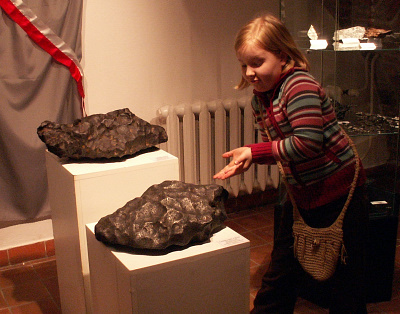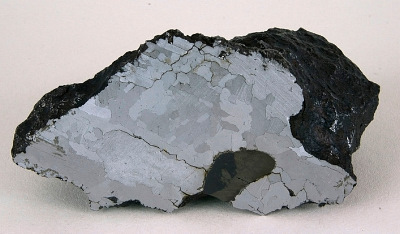IMCA Insights – February 2011
The Morasko iron shower – a few scientific
and ethical questions
by Andrzej S. Pilski
In recent years meteorite hunters, armed with modern metal detectors, raised Morasko to the position of the largest European iron shower. Despite those numerous finds our knowledge of the shower itself has not increased as some finders have refused to share with scientists details about their finds. Most often locations were kept secret as finders apparently did not want to see other hunters in their hunting area. Treasure hunters, more specifically, interested only in getting money for their finds, did not inform scientists at all and tried to sell their finds in Germany hoping to get more money. That is why a team of researchers, headed by Dr. Andrzej Muszyński, professor in the Institute of Geology of the Adam Mickiewicz University in Poznań, Poland, is still unable to estimate the size of the whole Morasko meteorite shower.
The very first find
of Morasko from 1914, now in the collection of the
Institute of Geological Sciences of the Polish Academy of Sciences.
(Photo courtesy of ING PAN)
The Morasko iron became known to science on November 12, 1914 with its discovery during the digging of trenches near the village of Morasko, then only a few kilometers north of the city of Poznań. Today Morasko is incorporated into Poznań, so one may expect new finds during excavations for new buildings. The finder, sergeant, Dr. Cobliner, wrote in a letter to the director of a museum in Poznań (then Germany), that about half of meter under the surface he had found a lump of metal weighing 75 kg. A fragment of the lump was sent to the Geologishe Landesanstalt in Berlin, where it was recognized as a meteorite. The main mass was left in Poznań in a Polish museum, as in 1918 Poland reemerged as an independent country.
The 78 kg find from
1947 displayed behind a "common" Campo
del Cielo in the Mineralogical Museum in Wrocław, Poland.
In 1954 Dr. Jerzy Pokrzywnicki, who wanted to find all meteorites preserved in Polish collections after World War II, found in the museum not only the first find, but also a few smaller rusty lumps of iron. Thinking that it could be a meteorite shower, he started to ask the residents of Morasko about possible finds of lumps of iron. He soon found in a farmyard an iron mass of 78 kg, which the farmer had ploughed up in the fall of 1947 and had brought back to his yard. Another farmer told him that before World War II a mass of 80 kg and eight other masses of 1.5 to 8 kg had also been ploughed up. Most of them had been lost, but a few could be the individuals Dr. Pokrzywnicki had found in the museum.
The 30 kg lump (not
cleaned) of Morasko
found by Krzysztof Socha in 1995.
Thinking that more iron masses might still be waiting to be found in the area Dr. Pokrzywnicki asked the army for help. Soldiers armed with military mine detectors checked the fields around the village of Morasko but their search was unsuccessful. So those meteorites had to wait until 1990 to be found. By then the interest in meteorites had increased in Poland and beginners meteorite hunters armed with modern metal detectors started to search in Morasko. Their hard work and better equipment soon resulted in new finds. In 1995 two larger specimens, about 30 kg and 40 kg were found plus many smaller ones, from a few kilograms to few dozen grams. Then every year more and more specimens were added to the list, culminating with the discovery of the largest one in 2006.
The largest Morasko
find (164 kg after cleaning) cut open and etched.
Note numerous, rounded inclusions of troilite/graphite.
(Photo courtesy of Dr. A. Muszyński)
However, this flurry of meteorite hunters around Morasko brought up some questions, which are not limited to the Morasko case. Are meteorite hunters helpful to scientists or not? There are no doubt that only the efforts of private meteorite hunters made the recent scientific work on the Morasko meteorite possible. However it is quite clear that some hunters worked only for themselves, keeping secret their finds and possibly even spreading false information. As an example, I found on Ebay-Germany a mass of about 22 kg, an uncleaned Morasko that was offered for sale. Its discovery was never reported to Dr. Muszyński.
A lump of Morasko
(about 22 kg) removed illegally from Poland
and offered for sale on Ebay about 2 years ago.
(Photo from the Ebay offer)
Scientists are less concerned about the numerous small finds of Morasko. Of course it would be great to know the exact location and size of each and every find, but missing some of them does not change seriously the general picture of the strewnfield. Largest finds however are much more important. In 1999 a finder asked some scientists to check a mass of iron, about 90 kg, reportedly found west of Morasko. The finder did not want to show exactly where his specimen had been found. After confirming that it was a meteorite the Polish Geological Institute offered the finder a rather good price for his find, but the finder refused to sell. Then the finder and the specimen disappeared. There is a rumor that the specimen was sold to somebody in Germany.
A half specimen, 2.6
kg, of Morasko with troilite/graphite
inclusion (bottom) and some cohenite (left edge)
To make it more difficult to remove from Poland meteorites that are of interest for science, a statement that exporting meteorites from Poland needed a written permission from the Department of Protecting Environment was added to the Act on Protection of Environment, which passed in 2004. It seems however that this law is unknown and last year when I took a few specimens from my own collection for a show in Winchester, UK, nobody at the airport checkpoint was interested and asked if I had any permission. Still, the law exists and could be used when necessary.
A small, windowed specimen of Morasko, 87.7g
In my country people used to say that "Law is law but life is life". Although the Act on Protection of Environment does not explicitly mention meteorites (except in the case of exportation), meteorites must be regarded as natural specimens of interest to science. In fact this Act states that every specimen that could possibly be of interest for science should be shown to an Office of Conservator of Nature, allowing that Office to decide if it is indeed important for science. If it is not important, the finder may own his find; if it is, the find should be given to authorities, and the finder should receive a prize.
A half specimen of
Morasko, 243g, with shock deformations
of the Widmanstätten pattern.
In reality the law does not work. At best a finder asks a scientist to check if his find is meteoritic. As this is the only way to get some information about meteorite finds, no scientist is willing to inform authorities and start the legal procedure. Everybody knows that and if one did then nobody would ever inform him about new finds. So scientists have a hard choice: to be a good citizen and inform authorities about illegal behavior and lose scientific data, or to become the accomplice of an illegal meteorite hunter to get material for science research. Apparently a law, which creates such dilemma, is not a good law but… law is law.
A full slice of
Morasko, 1083g, with troilite (rimmed with
schreibersite), graphite and cohenite inclusions.
Note that the cohenite follows Widmanstätten pattern.
The slice is cut from the 30 kg (1995) find shown above.
What about ethics? As a meteorite enthusiast I would call someone's behavior to be ethical, legal or not, when it helps in protecting meteorites from rusting in soil and in bringing the specimens for research with all data necessary. So I would call unethical a meteorite hunter who keeps hidden all the information about his finds because he thinks it will help him make more money.
A half specimen of
Morasko, 334 g, with Campo-type pattern.
Note flurry of Neumann lines at left and wide kamacite band
(upper center) with schreibersite inside.
That said
I would like to ask ethical meteorite collectors for their help in a way
similar to what Dr. Svend Buhl did in the case of Bassikounou. If you
have a larger specimen of the Morasko meteorite in your collection, say
above 1 kg, please let me know its weight, general appearance (photo, if
possible) and the exact location of the find if it was not right in
Morasko. The information may be anonymous, but if not, all personal data
will be kept secret anyway. The only purpose of my inquiry is to
evaluate the Total Known Weight of the Morasko meteorite and the size of
its strewnfield if possible.
Many thanks in advance!
Andrzej S. Pilski
aspmet@wp.pl
(Photos by the author unless another source is mentioned.)
This article has been edited by Anne Black and Norbert Classen
•
IMCA Home Page •
IMCA Code of Ethics •
IMCA Member List
•
Join IMCA •
IMCA Meteorite Info

